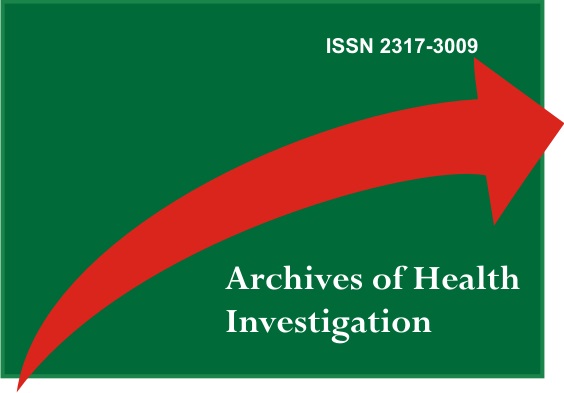Bioprogressive Therapy and use of the base arch: literature review
DOI:
https://doi.org/10.21270/archi.v10i5.5005Keywords:
Epidemiology, Orthodontics;, Tooth MovementAbstract
Malocclusions are among the public health problems and are considered by the World Health Organization to be the third dental problem, preceded by periodontal disease and dental caries. There are many techniques for correcting malocclusions, including the Ricketts base arch. The base arc is the mechanical unit of bioprogressive therapy from which all other arcs originate. Thus, the objective of this study was to discuss the importance of the base arch or Ricketts utility arch according to the experience of several authors through a brief review of the literature. To carry out this work, a bibliographic survey was carried out in the databases Pubmed, SciELO and Bireme (BVS). As it is a bibliographic review, the present data was collected only from existing documents, and it is not necessary to apply any research to survey results. The terms used were: “Arco base” and “Ricketts” and the inclusion criteria were: epidemiological studies, clinical studies in humans and clinical case reports. It was concluded with this bibliographic review, that the Base Arch is a symbol of an extremely intelligent orthodontic mechanics. It is capable of carrying out the necessary actions for the positioning of the teeth according to a detailed planning, allowing the work often simultaneous in the three space planes.
Downloads
References
Dimberg L, Arnrup K, Bondemark L. The impact of malocclusion on the quality of life among children and adolescents: a systematic review of quantitative studies. Eur J Orthod. 2015;37(3):238-47.
Fields HW. Craniofacial growth from infancy through adulthood. Background and clinical implications. Pediatric Clinics of North America. 1991;38(5):1053-88.
Peres KG, Traebert ESA, Marcenes W. Differences between normative criteria and self-perception in the assessment of malocclusion. Rev Saúde Pública. 2002;36(2):230-36.
Garbin AJI, Wakayama B, Rovida TAS, Garbin CAS. Neurocclusal rehabilitation as a treatment for posterior crossbite: case report. Braz J Surg Clin Res. 2015;11(4):21-4.
Primozic J, Richmond S, Kau CH, Zhurov A, Ovsenik M.Three-dimensional evaluation of early crossbite correction: a longitudinal study. Eur J Orthod. 2013;35(1):7-13.
Chibinski ACR, Czlusniak GD, Melo MD. Planas direct tracks: orthopedic treatment to correct functional crossbite. R Clin Ortodon Dental Press. 2005;4(3):64-72
Garbin AJI, Wakayama B, Santos RR, Rovida TAS, Garbin CAS. Planas direct tracks for the treatment of posterior crossbite. Rev Cubana Estomatol. 2014;51(1):113-20.
Camargo MCF, Mariani R. A Maloclusão e seus efeitos na articulação: o terceiro maior problema de saúde bucal. http://odontologika.uol.com.br/maloclusao.htm.
Ricketts RM. Logic and Keys to Bio Philosophy and Treatment Mechanics. Scottsdale AZ: American Institute for Bioprogresive Education; 1986. p. 98.
Reitan K, Rygh P. Principios e reações biomecânicas. In: Graber TM, Vanarsdall Júnior RL. Ortodontia: Princípios e técnicas atuais. 2. ed. Rio de Janeiro: Guanabara Koogan; 1996.
Garbin AJI, Pinto EG, Grieco FAD. Bioprogressiva e reabilitação neuro-oclusal: a evolução da ortodontia. Araçatuba: Somos; 2009.
Weiland FJ, Bantleon HP, Droschl H. Evaluation of continuous arch and segmented arch leveling techniques in adult patients--a clinical study. Am J Orthod Dentofacial Orthop. 1996;110(6):647-52.
Strang RHW. Tratado de ortodontia. Buenos Aires: Bibliografia Argentina; 1957.
Angle EH. Classification of Malocclusion: Dental Cosmos. 1899;41:248-64.
Minomi FM. A importância do tratamento ortodôntico precoce [monografia]. Piracicaba: Universidade Estadual de Campinas, Faculdade de Odontologia de Piracicaba; 2014.
Souza CC, Coura PE, Coura LC, Oliveira SS. Prevalência de maloclusão Classe I, II e III de Angle em um Curso de Especialização em Ortodontia da Cidade de Anápolis. Sci Invest Dent. 2016;21(1):29-33.
Sfalsini, AS. Diferenças e semelhanças entre a técnica do arco contínuo e a terapia bioprogressiva [monografia]. São Paulo: Curso de Especialização em Ortodontia, Universidade Cruzeiro do Sul; 2008
Figueiredo MA, Figueiredo CTP, Nobuyasu M, Gondo GY, Siqueira DF. A versatilidade clínica do arco utilidade. Rev. Dent. Press Ortodon. Ortop. Facial. 2008;13(4):127-56.
Ricketts RW, Bench CF, Gugino JJH, Schulhof RJ. Denver: Rocky Mountain Orrhodonrics; 1979
Almeida MR, Vieira GM, Guimarães Jr. CH, Amad Neto M, Nanda R. Emprego racional da Biomecânica em Ortodontia: "arcos inteligentes". Rev Dent Press Ortodon Ortop Facial. 2006;11(1):122-56.
Vaz CM. Arco Ricketts base in intrusion dental - report of case. Rev Odontol Araçatuba. 2015;36(1):14-23.
Otto RL, Anholm JM, Engel GA. A comparative analysis of intrusion of incisor teeth achieved in adults and children according to facial type. Am J Orthod. 1980;77(4):437-46.
Mcnamara Jr JA. Ordinary Orthodontics: starting with the end in mind. World. J Orthod Carol Stream. 2000;1:45-54.
Sellke TA. Zero base bioprogressive: unlocking the door to the future. Semin Orthod. 1998;4(4):210-18.
Gurgel JA, Ramos AL, Kerr SD. Fios ortodônticos. Rev Dental Press Ortod Ortop Facial. 2001;6(4):103-14.
Preston CB, Kozlowski J, Evans B. Adaptation of the bioprogressive philosophy to use brackets with .022" slots. Semin Orthod. 1998;4(4):238-45.
Garbin AJI, Wakayama B, Martin IM. Filosofia Bioprogressiva de Ricketts e Arco Seccionado de Forças Paralelas no Tratamento da Classe II: relato de caso. Arch Health Invest (2020) 9(1):49-54.


